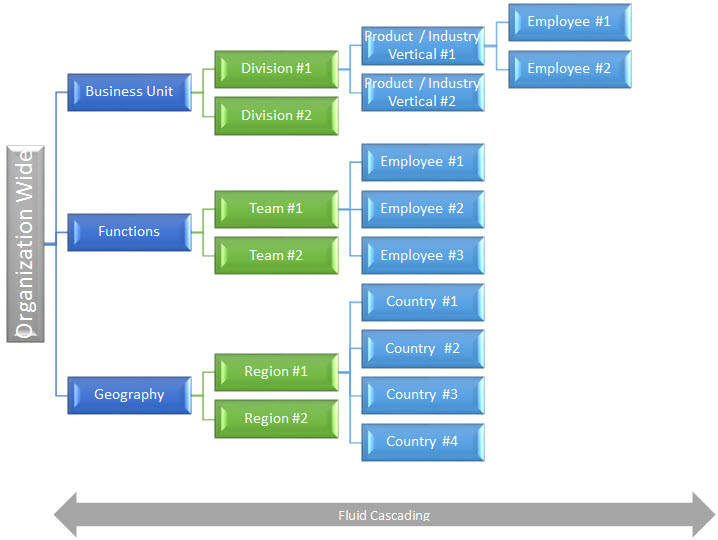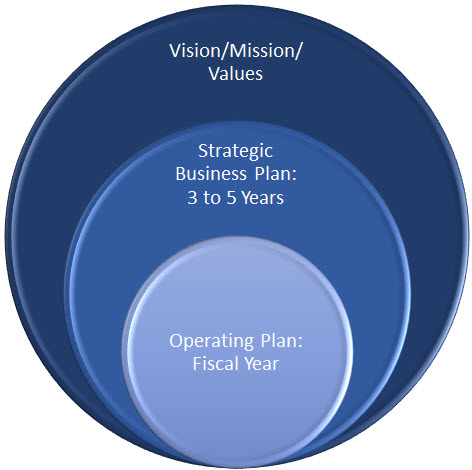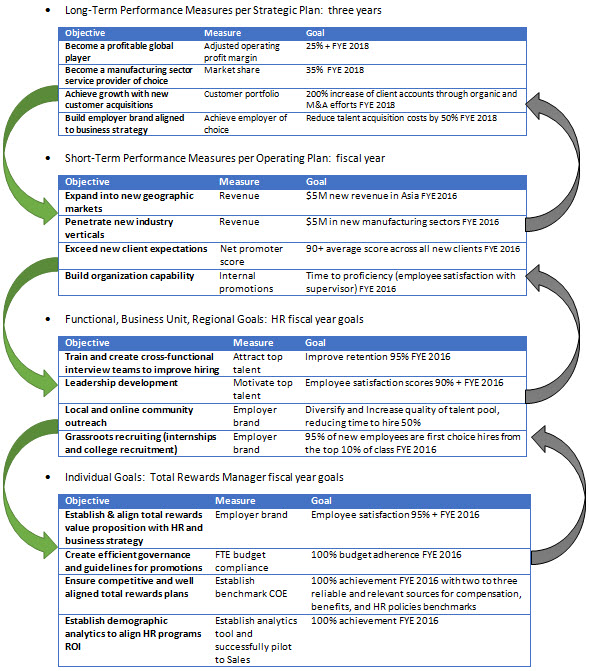Total rewards leaders are instrumental in improving business performance by ensuring that financial and non-financial reward systems are aligned to business strategy, HR strategy, and organization culture (see WorldatWork’s updated total rewards model introduced this year). Performance management is often used by total rewards leaders to help drive a sustainable performance culture with short-term and long-term alignment of SMART (Specific, Measurable, Attainable, Relevant, and Time-base) goals. In order to take the mystery out of this topic, goal alignment will be demonstrated below by way of example.
For goal alignment in performance management to occur, business leaders begin by establishing a business plan using a cascading communication approach, fostering a collaborative flow of information that cascades up, down, and across the organization. This approach ensures that appropriate stakeholders ( e.g., project sponsors, process owners, change agents, and front line employees) provide insight to customer needs, organization capability, and related mission critical considerations to move the organization forward, thereby creating a line of sight that engages employees. The graphic below depicts fluid, cascading communication on a continuum from the organization-wide level to the individual employee.

Business Plan
Since goals are defined based on business plans, it is important to provide a well-articulated, long-term strategic business plan that includes shorter fiscal year operating plans. The “glue” to alignment is having a business plan that is consistent with the organization’s vision, mission, and values. Depending on the organization’s size, culture, and business cycle, HR leadership may also have to facilitate these discussions to determine the details of the business plan as the basis of goal setting.

Human resources leadership provides input to the business planning process, addressing the following business imperatives:
- Strategic core competencies of your organization with general direction for leveraging strengths
- Ensuring that total rewards and HR programs for the related jobs and their incumbents are effective
- Organization capability gaps and specific actions to fill them or minimize their risks
- Understanding how job design will affect talent acquisition or retooling in relation to incremental labor and training costs
Effective business planning should provide insight to the following mission critical items:
- Value chain and related cost drivers
- How do we create value for our customers?
- What are the related costs, expenses, and capital investments?
- Internal and external risk assessment
- What are the strengths, weaknesses, threats, and opportunities of achieving the strategic and operating plan?
SMART Goals
With well-articulated business plans in hand, HR leadership can help to drive this cascading process to set SMART goals with business leaders, creating a roadmap to achieve the business plans. Below are examples of SMART goals that cascade from a strategic three-year business plan, a fiscal year operating business plan, HR function goals, and individual goals of a total rewards manager.

The true test of whether goals are aligned is to read them in both directions and ensure that they are well integrated. Total rewards leaders should also guide the goal setting process with an understanding of infrastructure capabilities to reliably measure specific business outcomes, ensuring that stakeholders have confidence in the process.
Summary
This broad HR topic has been provided to assist readers in designing performance management and goal setting processes and evaluating processes currently in place. By applying a cascading communication approach to the business planning and goal setting process, HR leadership can achieve alignment all the way to the individual employee level. With fluid communication, all stakeholders (e.g., project sponsors, change agents, process owners, and front line employees) are engaged and committed to achieving the goals. There are technologies that enable organizations to set up efficient, automated workflows for managing the whole performance management and goal setting process. An automated solution, combined with an effective performance management and goal setting process, is often a winning combination.
In addition to this blog, a related ERI white paper on performance measures is available.


